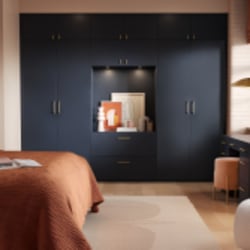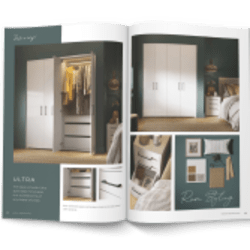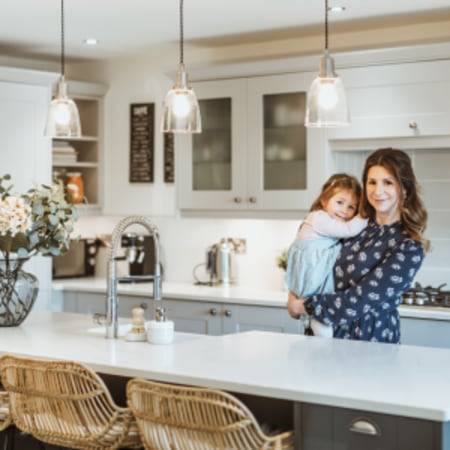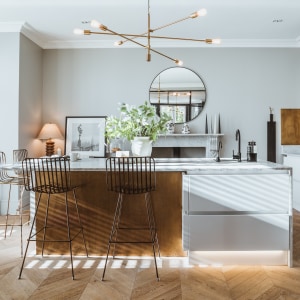Kitchen Lighting: Buying Guide
Kitchen Lighting
Lighting is arguably more important in the kitchen than in any other room in the house, given that it serves a vital function in food preparation while also contributing to the look and feel of the room.
Various different types of lighting are commonly used to ensure areas of the kitchen are properly lit, and developments in kitchen lighting technology mean that it is now easier than ever to find the best type of lighting for kitchen designs regardless of whether you are aiming for a traditional or modern style.
In this article we will guide you through the key considerations to make when planning your kitchen design, to ensure you find the types of lighting that work best for your specific requirements.
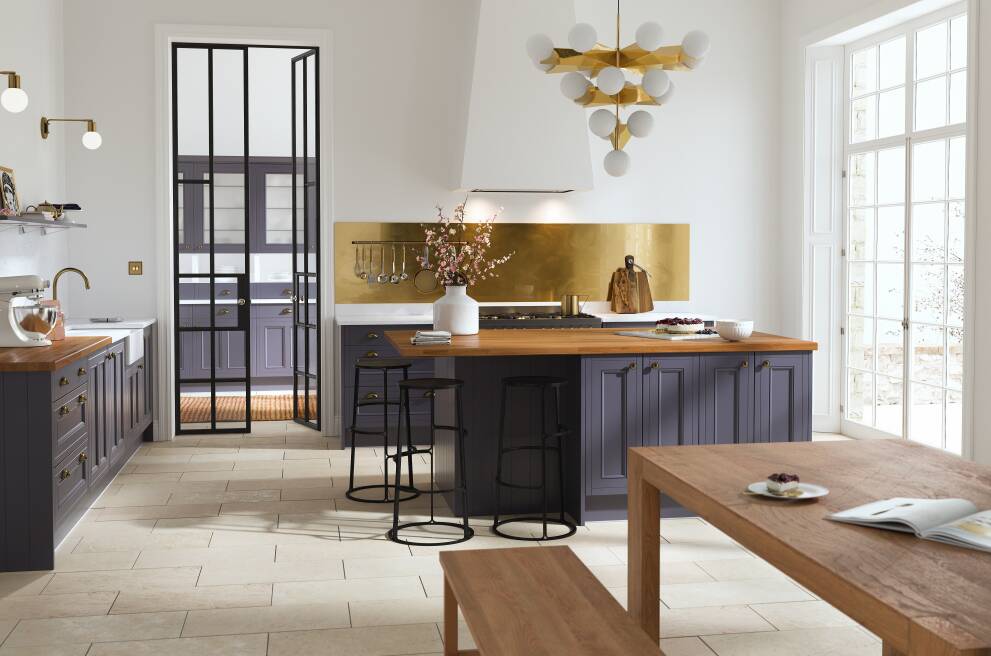
Before you start
There are some important factors to consider before you explore the different types of lighting that might suit your kitchen design.
To avoid the possibility of spending money on an unsuitable lighting fixture, take some time to incorporate the following elements into your plan.
Size and layout of the kitchen
By drawing up a plan of the size and intended layout of your completed kitchen, you will be able to assess the requirements for general lighting, task lighting and accent lighting, and work out the best type of lighting for a kitchen based on your specific layout and needs.
It is important not to leave a large kitchen underlit, nor place too much lighting within a room that does not need it. Think about ambience and atmosphere as you plan your kitchen lighting.
The height of your kitchen's ceiling is another important factor. Recessed or spot lighting will have further to travel in a tall kitchen, where pendant lighting might be a more suitable choice. On the flip side, if your kitchen ceiling is low, then pendant lighting may not be a viable option.
If your kitchen is L-shaped or T-shaped, consider whether track lighting might help you to ensure an even spread of ambient light, or if carefully placed recessed spotlights might do a better job.
Natural light
A key part of the plan you draw up for your kitchen will be the position and size of your kitchen windows.
If your kitchen receives a good amount of natural light during daylight hours, then you may not require electric lighting as a priority in certain areas. For example, if you tend to eat breakfast at a table near a window, you are unlikely to need to place lamps or spotlights in that area.
If, on the other hand, your kitchen does not receive much natural light, such as in the case of kitchens that have few windows or are located at basement level, you will need to ensure your kitchen lights are capable of illuminating the entire room throughout the day and night.
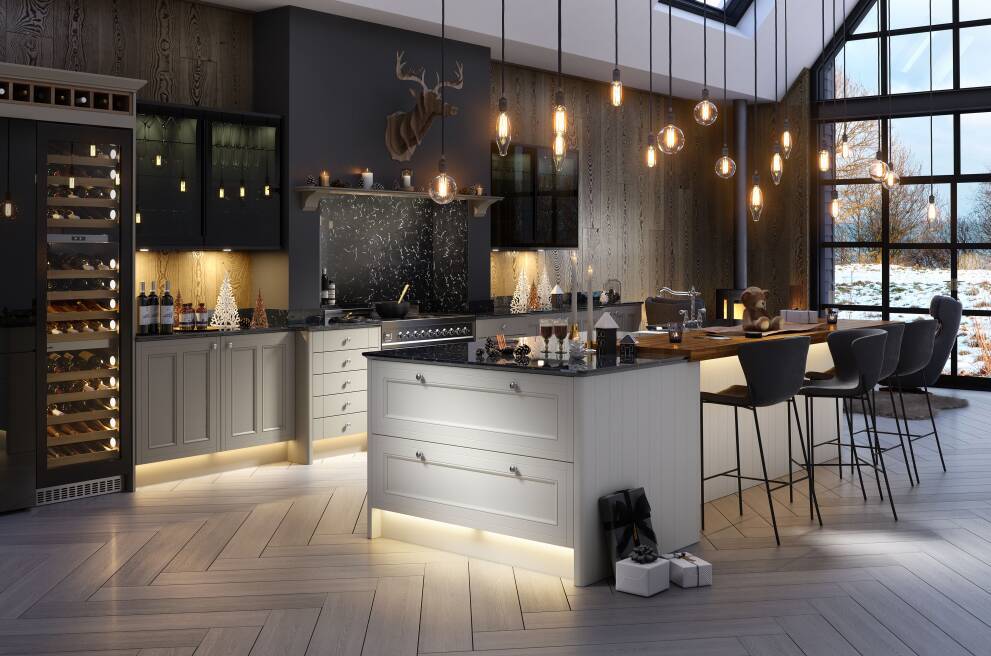
Budget
When you come to buy lighting for your kitchen, you'll find that the various types of kitchen lighting are generally produced at price points to suit all budgets, with some exceptions.
If you're looking for a chandelier for your kitchen, as well as needing plenty of headroom to fit it you will most likely need to extend your budget in order to incorporate this typically pricey form of light fitting.
Tube lighting can also be expensive due to its components costing more than smaller light fixtures.
When it comes to recessed, pendant and task lighting, you really can find items at prices to fit any budget, although quality must be taken into account given that purchasing cheap lighting can prove to be a false economy, as you find yourself having to buy replacements sooner rather than later.
Types of kitchen lighting
When choosing kitchen lighting, it is not a case of having to find one type of lighting to cover your entire kitchen.
That's the beauty of a room that for many of us serves many different purposes: we can mix and match the lighting we use in the room to ensure it functions exactly as it should while we prepare food, cook, entertain guests and spend time with our families.
Let's take a look at the main types of lighting you will want to consider installing in your kitchen. Perhaps you'll only need one or two, or maybe you'll want to incorporate them all!
Task lighting
Anyone who has ever attempted to chop an onion in low light conditions will appreciate the vital importance of good task lighting in a kitchen.
There are particular areas in a kitchen that need to be well lit for safety purposes, and the first and foremost of these is the stove. Whether your cooker is located at the side of your kitchen or on an island, you will need to make sure it receives bright, even light from above to allow you to cook safely without the interference of shadows.
The next priority for task lighting is your worktops. Many kitchens feature surfaces that are overshadowed by wall cabinets, and this can create problems during food preparation. A great example of task lighting is under-cabinet lights on wall cabinets, which not only illuminate worktops beneath them for safe food preparation but also create a wonderful ambient atmosphere in the room.
You might also want to consider adding task lighting for your sink if it does not benefit from sufficient light from other sources, and if your kitchen features a dining table then a well-placed lamp or pendant light can offer dining lighting that transforms mealtimes into a much more vibrant experience.
Track lighting
Track lighting is a method by which you can illuminate specific areas of your kitchen by attaching bulbs to a metal strip or wire, known as a track.
Suitable for use as ambient lighting for the entirety of your kitchen or as a source of task or accent lighting, task lighting is wonderfully versatile. The metal strip to which bulbs are attached can be flush with the ceiling or suspended below it, and you can find tracks in a wide range of lengths, shapes and styles.
If you have an L-shaped or T-shaped kitchen, you can use task lighting to ensure all areas of the room receive an equal amount of ambient light. Track lighting can also be used as task lighting under cabinets, or as accent lighting to illuminate walls or cabinets.
One of the benefits of track lighting is that if one of the lamps in your track lighting goes out, you don't have to replace the entire fitting – just replace the bulb, ensuring the replacement does not exceed the maximum wattage of the track light fixture.
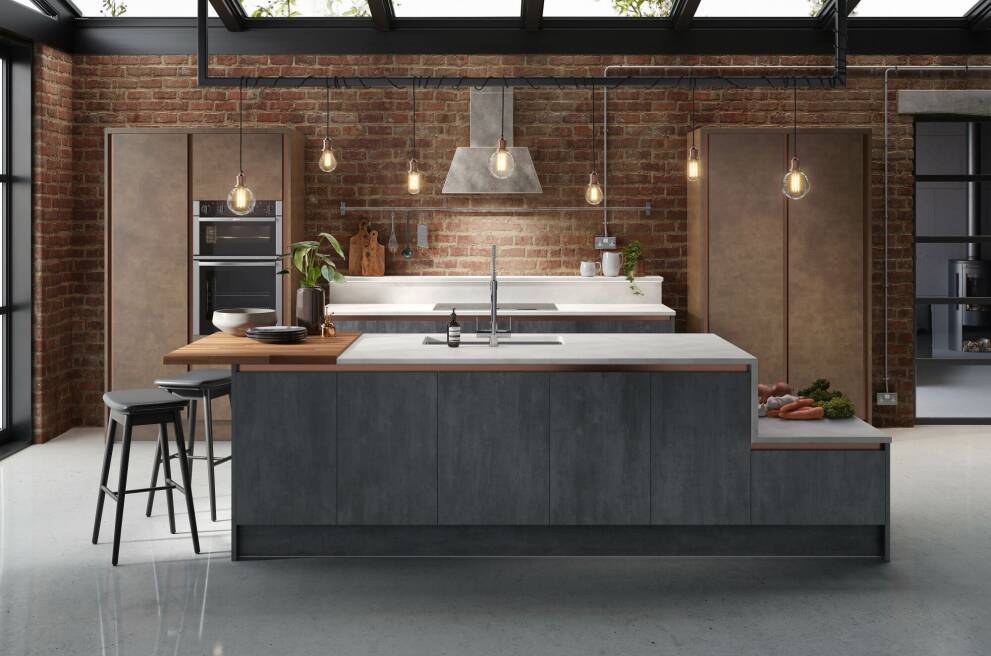
Spotlights
Spotlights are particularly useful for highlighting certain areas that you want to draw attention to in your kitchen.
LED spotlights can be tucked into the smallest of spaces, so if you have an open cabinet whose contents you wish to illuminate then you could recess a spotlight above it to bathe it in light. You could even add glass shelving to the cabinet to allow the light to cascade down through the layers.
Kitchen spotlights can be added to a track and pointed in different directions to spread light around your kitchen, and you can even use spotlights in different colours to match the colour scheme of your kitchen and create immersive ambience in the room.
Pendant lighting
Pendant lighting can be the focal point of a kitchen when it is carefully chosen, but it is important to choose a pendant light whose size and style will complement the features around it.
While small pendant lights can work in compact kitchens with low ceilings, pendant lighting in the centre of a kitchen tends to need plenty of room around it. Highly stylised pendants in particular need space so that they can be properly appreciated and to prevent them from overwhelming a kitchen's design.
Pendant lighting can also be used as task lighting, and is a popular choice in kitchens with an island. A low-hanging pendant light over an island can create a positive focus on an important area of the kitchen.
Another advantage of pendant lighting is that it is available in a wide range of materials and colours, allowing you to really set your kitchen design off with a well-chosen pendant light. Copper, brass and glass pendants are particularly popular among those who want a light fitting that really catches the light and the eye.
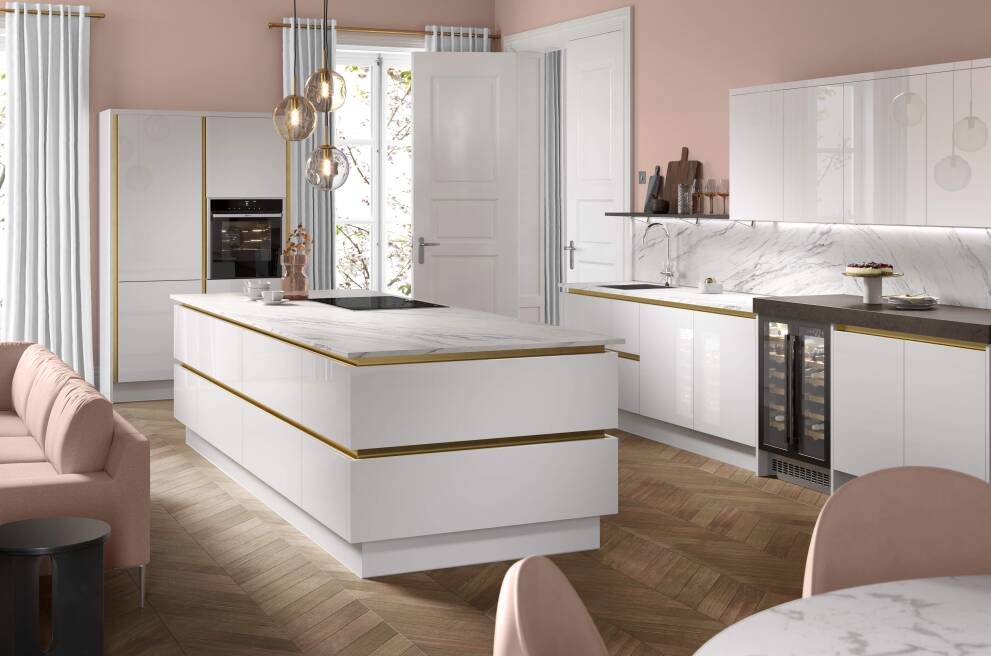
Under cabinet lighting
As mentioned above, under cabinet lighting can be a highly effective form of task lighting but it also adds a unique ambience in your kitchen.
Kitchen designers tend to use strip lights or spotlights when adding under cabinet lighting. Strip lights provide unbroken lighting over a wide area and are comprised of a long, narrow sequence of lights or a long, singular bulb. Spotlights placed under cabinets are individual bulbs that light up a concentrated area.
When choosing under cabinet lighting, consider whether you would prefer to use fluorescent lighting or LED lights.
Fluorescent lights are often cheaper but can take longer to reach their full brightness, whereas LED lights offer the benefits of being highly energy-efficient, long-lasting, and providing instant illumination.
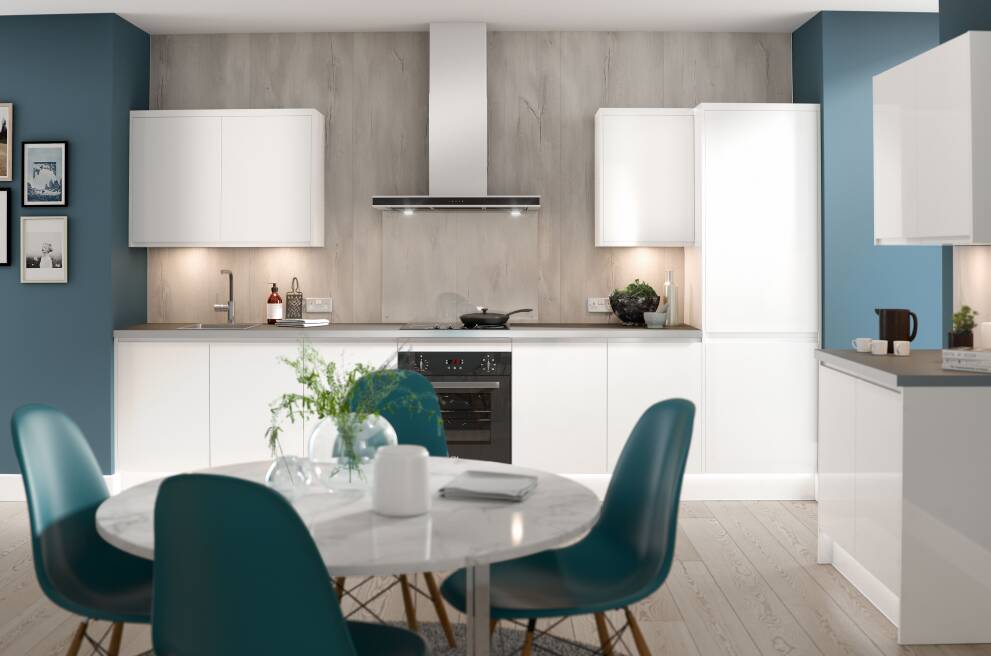
Other things to consider
Having carefully considered your space, your budget, and the types of lighting that might work well in your kitchen, you are almost there! But before you take the plunge and buy lighting for your kitchen, take a moment to factor in the following.
IP rating
An IP rating tells you how well a product resists or blocks out foreign bodies. IP stands for ingress protection, and when it comes to kitchen lighting you need to think about whether the products you buy will resist moisture generated by steam as well as condensation or water drips.
Products rated IP20 or higher will ensure your lighting copes with the often moist and hot environment of the kitchen.
Light switches
Don't allow your beautiful kitchen lighting choices to be let down by switches that are poorly positioned or don't match your aesthetic.
You can find light switches to suit every kitchen design, from metallic toggle switches for period style kitchens to dimmer switches for a suave modern feel.
Replacing your kitchen lighting is a great chance to improve the functionality of your kitchen by adjusting the number of light switches in the room as well as their positioning. Make sure every light switch, from accent and task lights to ambient room lighting, is within easy reach.
Lightbulbs
Different types of kitchen lighting require different bulbs, and it's important to know which bulbs fit your lights so that you can easily replace them.
There are various types of cap fittings to be found on different lightbulbs. Here in the UK, the most common types of lightbulb cap fittings are:
- Bayonet
- Small bayonet
- Edison screw
- Small Edison screw
- Spotlight
- Capsule
- Tube
These fittings can be found on different bulb shapes, and it pays to familiarise yourself with them so that you don't purchase an incorrect replacement.
The most common UK lightbulb shapes are:
- Traditional
- Candle
- Globe
- Mini globe
- ST64
- Reflector
- Capsule
- Decorative (covering various different shapes)
Whether you opt for halogen, LED or Smart LED bulbs in your kitchen, all of which come with their own brightness rating measured in lumens, you will need to make sure your bulbs match your light fixtures and find a reliable source of replacement bulbs for the inevitable moment that one of them goes out.
If in doubt, speak to us!
There is a lot to think about when it comes to kitchen lighting, but we are here to help. Our kitchen experts have decades of experience when it comes to kitchen fittings and lighting, and we can help advise you on what will work best for your kitchen - making Wren one of the best places to buy lighting.
You can not only buy lighting but also get advice on all types of lighting fixtures for your kitchen right here at Wren Kitchens.
Contact us today to book an appointment and allow us to help you illuminate your dream kitchen.








